Critical Review: Cost Management Strategies in Manufacturing Report
VerifiedAdded on 2022/11/07
|11
|2094
|446
Report
AI Summary
This report offers a critical review of Govin Naidu's article, "Essentials of Modern Manufacturing Part 1: Cost Management," examining five cost reduction strategies. The review analyzes vertical integration, outsourcing, and request for quotation methods, highlighting their effectiveness and potential drawbacks. It emphasizes the importance of a balanced approach to cost management, considering factors beyond simple cost reduction. The report also discusses catalog reduction and the need for a model to guide the selection of suitable strategies, acknowledging the complexity of cost management in modern manufacturing. It incorporates insights from various sources to provide a comprehensive analysis of the topic, emphasizing the need for a holistic approach that balances cost reduction with output efficiency and customer engagement.
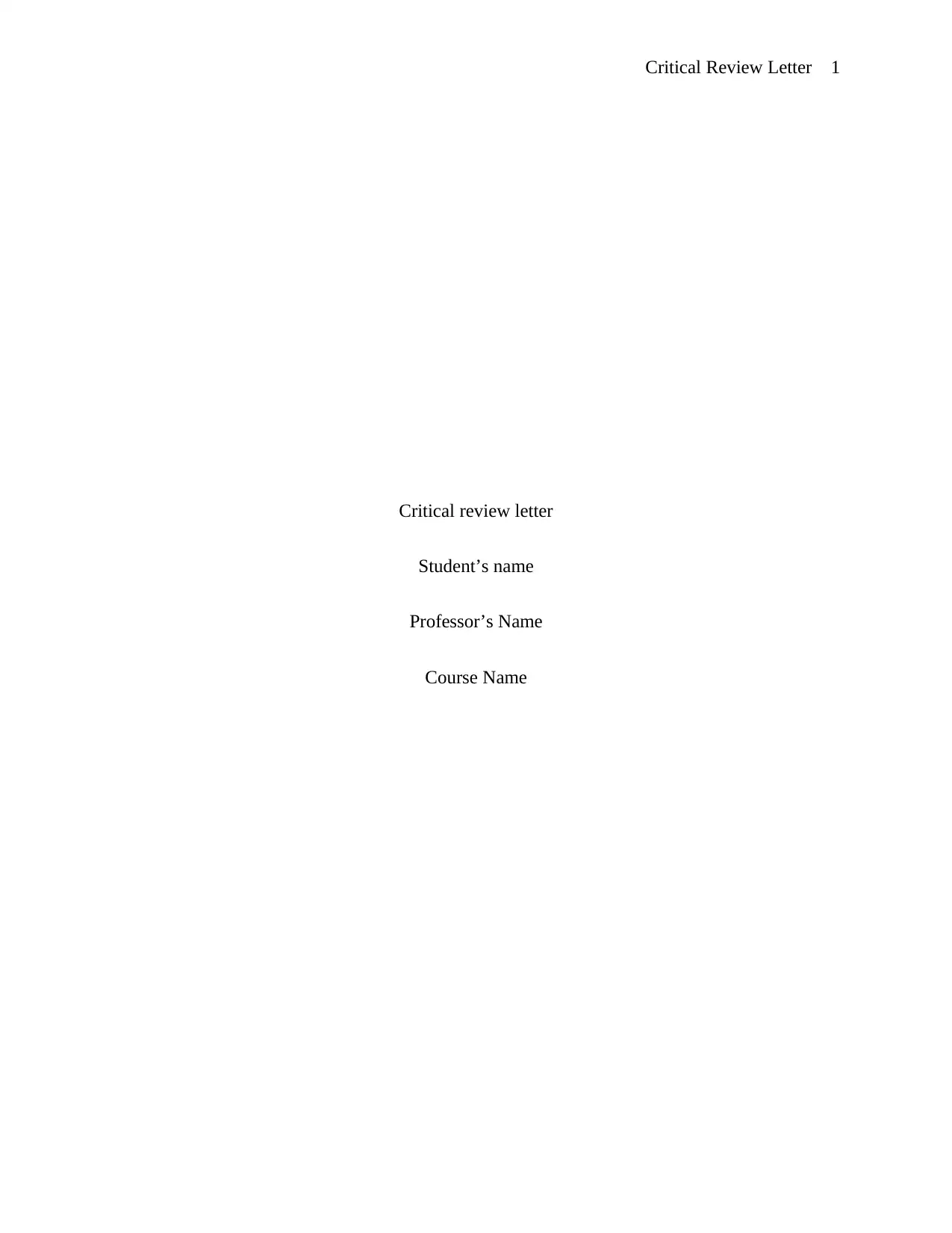
Critical Review Letter 1
Critical review letter
Student’s name
Professor’s Name
Course Name
Critical review letter
Student’s name
Professor’s Name
Course Name
Paraphrase This Document
Need a fresh take? Get an instant paraphrase of this document with our AI Paraphraser
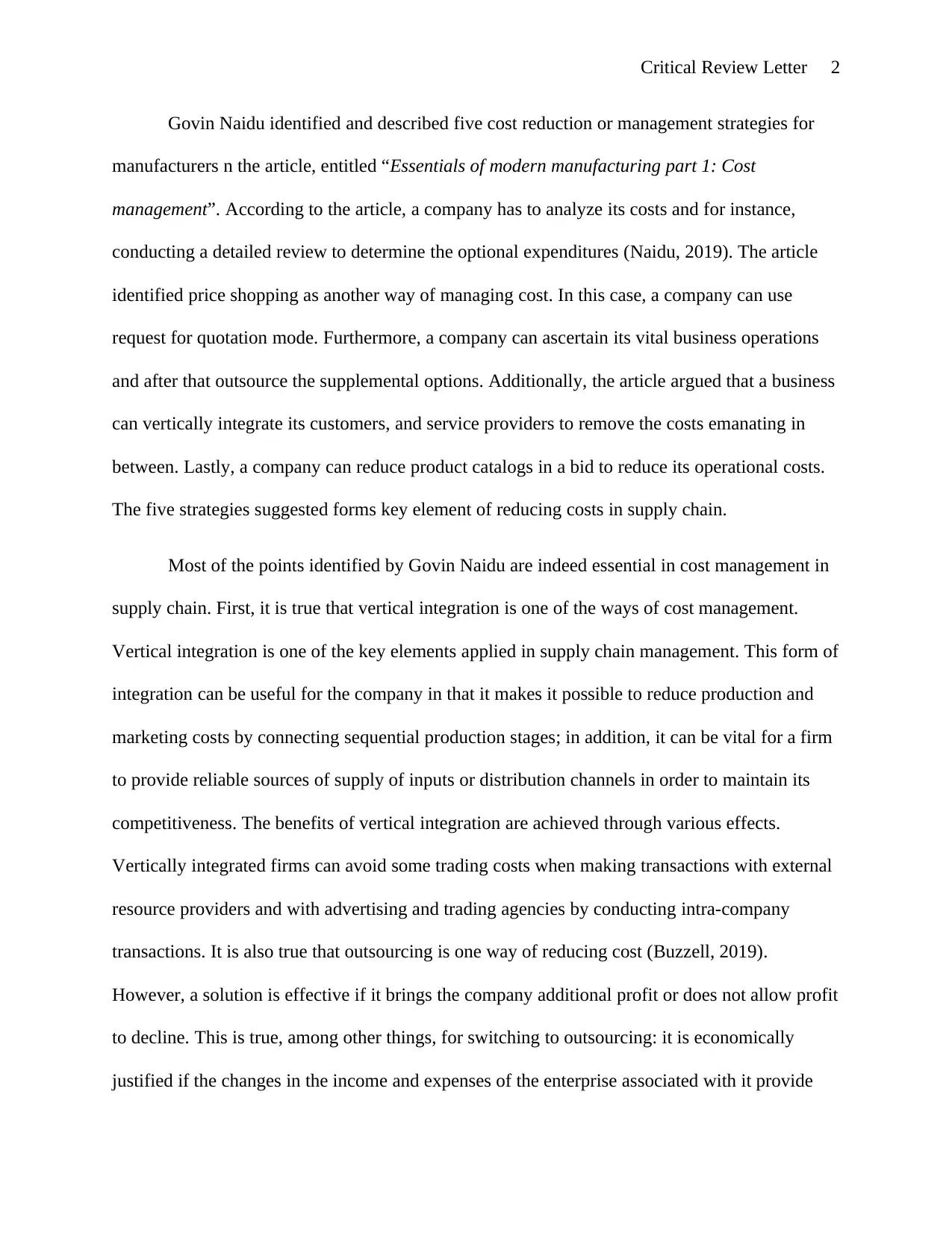
Critical Review Letter 2
Govin Naidu identified and described five cost reduction or management strategies for
manufacturers n the article, entitled “Essentials of modern manufacturing part 1: Cost
management”. According to the article, a company has to analyze its costs and for instance,
conducting a detailed review to determine the optional expenditures (Naidu, 2019). The article
identified price shopping as another way of managing cost. In this case, a company can use
request for quotation mode. Furthermore, a company can ascertain its vital business operations
and after that outsource the supplemental options. Additionally, the article argued that a business
can vertically integrate its customers, and service providers to remove the costs emanating in
between. Lastly, a company can reduce product catalogs in a bid to reduce its operational costs.
The five strategies suggested forms key element of reducing costs in supply chain.
Most of the points identified by Govin Naidu are indeed essential in cost management in
supply chain. First, it is true that vertical integration is one of the ways of cost management.
Vertical integration is one of the key elements applied in supply chain management. This form of
integration can be useful for the company in that it makes it possible to reduce production and
marketing costs by connecting sequential production stages; in addition, it can be vital for a firm
to provide reliable sources of supply of inputs or distribution channels in order to maintain its
competitiveness. The benefits of vertical integration are achieved through various effects.
Vertically integrated firms can avoid some trading costs when making transactions with external
resource providers and with advertising and trading agencies by conducting intra-company
transactions. It is also true that outsourcing is one way of reducing cost (Buzzell, 2019).
However, a solution is effective if it brings the company additional profit or does not allow profit
to decline. This is true, among other things, for switching to outsourcing: it is economically
justified if the changes in the income and expenses of the enterprise associated with it provide
Govin Naidu identified and described five cost reduction or management strategies for
manufacturers n the article, entitled “Essentials of modern manufacturing part 1: Cost
management”. According to the article, a company has to analyze its costs and for instance,
conducting a detailed review to determine the optional expenditures (Naidu, 2019). The article
identified price shopping as another way of managing cost. In this case, a company can use
request for quotation mode. Furthermore, a company can ascertain its vital business operations
and after that outsource the supplemental options. Additionally, the article argued that a business
can vertically integrate its customers, and service providers to remove the costs emanating in
between. Lastly, a company can reduce product catalogs in a bid to reduce its operational costs.
The five strategies suggested forms key element of reducing costs in supply chain.
Most of the points identified by Govin Naidu are indeed essential in cost management in
supply chain. First, it is true that vertical integration is one of the ways of cost management.
Vertical integration is one of the key elements applied in supply chain management. This form of
integration can be useful for the company in that it makes it possible to reduce production and
marketing costs by connecting sequential production stages; in addition, it can be vital for a firm
to provide reliable sources of supply of inputs or distribution channels in order to maintain its
competitiveness. The benefits of vertical integration are achieved through various effects.
Vertically integrated firms can avoid some trading costs when making transactions with external
resource providers and with advertising and trading agencies by conducting intra-company
transactions. It is also true that outsourcing is one way of reducing cost (Buzzell, 2019).
However, a solution is effective if it brings the company additional profit or does not allow profit
to decline. This is true, among other things, for switching to outsourcing: it is economically
justified if the changes in the income and expenses of the enterprise associated with it provide
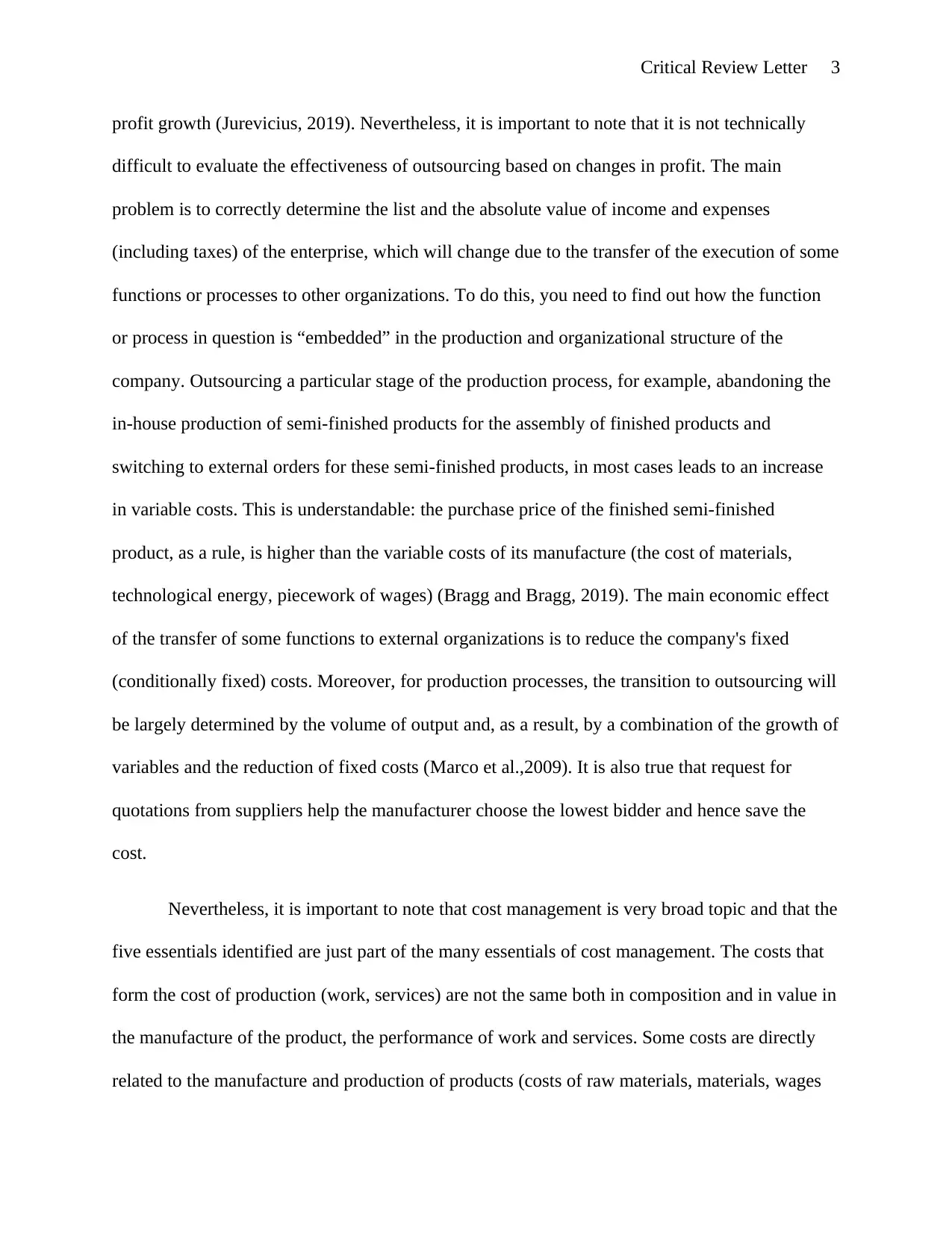
Critical Review Letter 3
profit growth (Jurevicius, 2019). Nevertheless, it is important to note that it is not technically
difficult to evaluate the effectiveness of outsourcing based on changes in profit. The main
problem is to correctly determine the list and the absolute value of income and expenses
(including taxes) of the enterprise, which will change due to the transfer of the execution of some
functions or processes to other organizations. To do this, you need to find out how the function
or process in question is “embedded” in the production and organizational structure of the
company. Outsourcing a particular stage of the production process, for example, abandoning the
in-house production of semi-finished products for the assembly of finished products and
switching to external orders for these semi-finished products, in most cases leads to an increase
in variable costs. This is understandable: the purchase price of the finished semi-finished
product, as a rule, is higher than the variable costs of its manufacture (the cost of materials,
technological energy, piecework of wages) (Bragg and Bragg, 2019). The main economic effect
of the transfer of some functions to external organizations is to reduce the company's fixed
(conditionally fixed) costs. Moreover, for production processes, the transition to outsourcing will
be largely determined by the volume of output and, as a result, by a combination of the growth of
variables and the reduction of fixed costs (Marco et al.,2009). It is also true that request for
quotations from suppliers help the manufacturer choose the lowest bidder and hence save the
cost.
Nevertheless, it is important to note that cost management is very broad topic and that the
five essentials identified are just part of the many essentials of cost management. The costs that
form the cost of production (work, services) are not the same both in composition and in value in
the manufacture of the product, the performance of work and services. Some costs are directly
related to the manufacture and production of products (costs of raw materials, materials, wages
profit growth (Jurevicius, 2019). Nevertheless, it is important to note that it is not technically
difficult to evaluate the effectiveness of outsourcing based on changes in profit. The main
problem is to correctly determine the list and the absolute value of income and expenses
(including taxes) of the enterprise, which will change due to the transfer of the execution of some
functions or processes to other organizations. To do this, you need to find out how the function
or process in question is “embedded” in the production and organizational structure of the
company. Outsourcing a particular stage of the production process, for example, abandoning the
in-house production of semi-finished products for the assembly of finished products and
switching to external orders for these semi-finished products, in most cases leads to an increase
in variable costs. This is understandable: the purchase price of the finished semi-finished
product, as a rule, is higher than the variable costs of its manufacture (the cost of materials,
technological energy, piecework of wages) (Bragg and Bragg, 2019). The main economic effect
of the transfer of some functions to external organizations is to reduce the company's fixed
(conditionally fixed) costs. Moreover, for production processes, the transition to outsourcing will
be largely determined by the volume of output and, as a result, by a combination of the growth of
variables and the reduction of fixed costs (Marco et al.,2009). It is also true that request for
quotations from suppliers help the manufacturer choose the lowest bidder and hence save the
cost.
Nevertheless, it is important to note that cost management is very broad topic and that the
five essentials identified are just part of the many essentials of cost management. The costs that
form the cost of production (work, services) are not the same both in composition and in value in
the manufacture of the product, the performance of work and services. Some costs are directly
related to the manufacture and production of products (costs of raw materials, materials, wages
⊘ This is a preview!⊘
Do you want full access?
Subscribe today to unlock all pages.

Trusted by 1+ million students worldwide
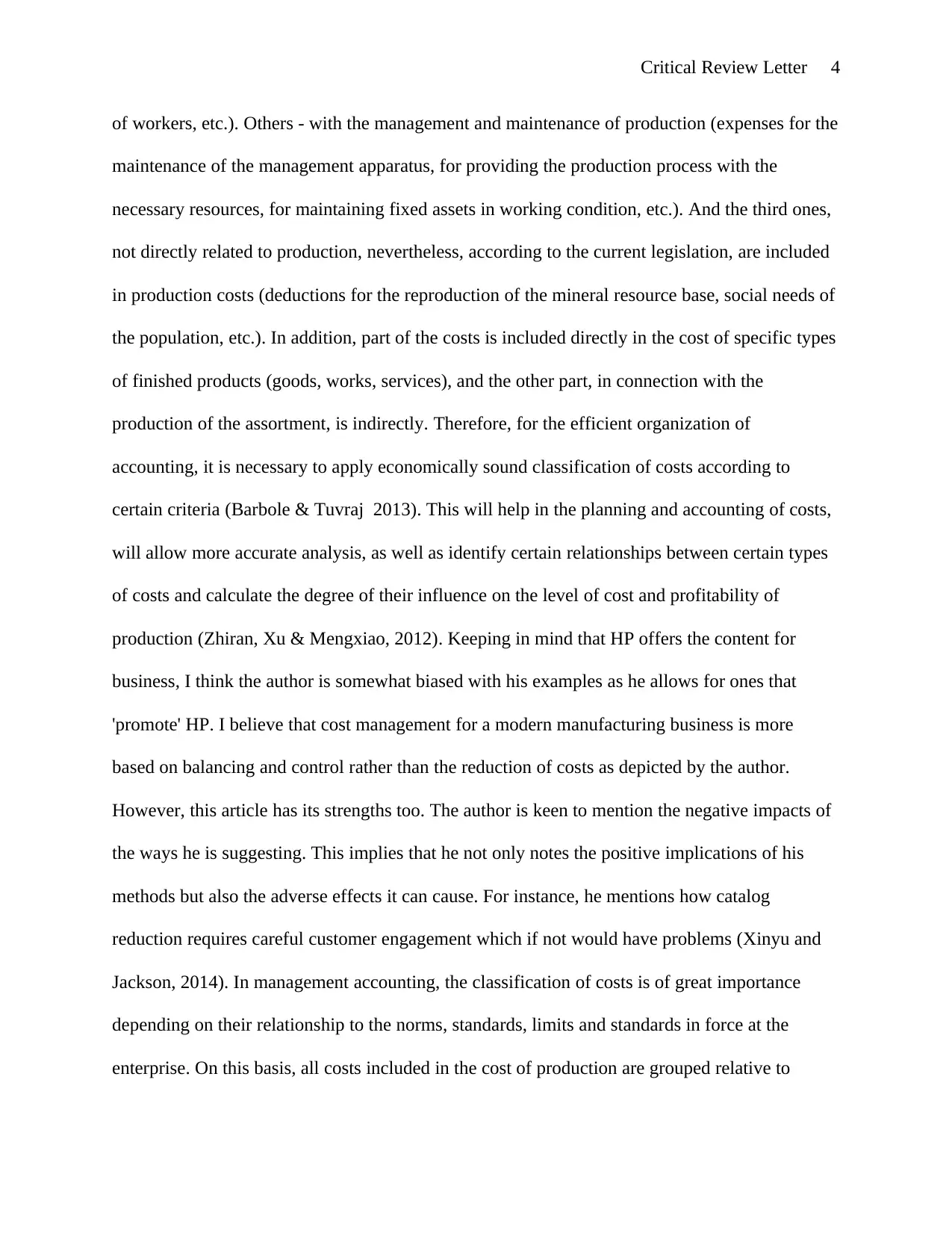
Critical Review Letter 4
of workers, etc.). Others - with the management and maintenance of production (expenses for the
maintenance of the management apparatus, for providing the production process with the
necessary resources, for maintaining fixed assets in working condition, etc.). And the third ones,
not directly related to production, nevertheless, according to the current legislation, are included
in production costs (deductions for the reproduction of the mineral resource base, social needs of
the population, etc.). In addition, part of the costs is included directly in the cost of specific types
of finished products (goods, works, services), and the other part, in connection with the
production of the assortment, is indirectly. Therefore, for the efficient organization of
accounting, it is necessary to apply economically sound classification of costs according to
certain criteria (Barbole & Tuvraj 2013). This will help in the planning and accounting of costs,
will allow more accurate analysis, as well as identify certain relationships between certain types
of costs and calculate the degree of their influence on the level of cost and profitability of
production (Zhiran, Xu & Mengxiao, 2012). Keeping in mind that HP offers the content for
business, I think the author is somewhat biased with his examples as he allows for ones that
'promote' HP. I believe that cost management for a modern manufacturing business is more
based on balancing and control rather than the reduction of costs as depicted by the author.
However, this article has its strengths too. The author is keen to mention the negative impacts of
the ways he is suggesting. This implies that he not only notes the positive implications of his
methods but also the adverse effects it can cause. For instance, he mentions how catalog
reduction requires careful customer engagement which if not would have problems (Xinyu and
Jackson, 2014). In management accounting, the classification of costs is of great importance
depending on their relationship to the norms, standards, limits and standards in force at the
enterprise. On this basis, all costs included in the cost of production are grouped relative to
of workers, etc.). Others - with the management and maintenance of production (expenses for the
maintenance of the management apparatus, for providing the production process with the
necessary resources, for maintaining fixed assets in working condition, etc.). And the third ones,
not directly related to production, nevertheless, according to the current legislation, are included
in production costs (deductions for the reproduction of the mineral resource base, social needs of
the population, etc.). In addition, part of the costs is included directly in the cost of specific types
of finished products (goods, works, services), and the other part, in connection with the
production of the assortment, is indirectly. Therefore, for the efficient organization of
accounting, it is necessary to apply economically sound classification of costs according to
certain criteria (Barbole & Tuvraj 2013). This will help in the planning and accounting of costs,
will allow more accurate analysis, as well as identify certain relationships between certain types
of costs and calculate the degree of their influence on the level of cost and profitability of
production (Zhiran, Xu & Mengxiao, 2012). Keeping in mind that HP offers the content for
business, I think the author is somewhat biased with his examples as he allows for ones that
'promote' HP. I believe that cost management for a modern manufacturing business is more
based on balancing and control rather than the reduction of costs as depicted by the author.
However, this article has its strengths too. The author is keen to mention the negative impacts of
the ways he is suggesting. This implies that he not only notes the positive implications of his
methods but also the adverse effects it can cause. For instance, he mentions how catalog
reduction requires careful customer engagement which if not would have problems (Xinyu and
Jackson, 2014). In management accounting, the classification of costs is of great importance
depending on their relationship to the norms, standards, limits and standards in force at the
enterprise. On this basis, all costs included in the cost of production are grouped relative to
Paraphrase This Document
Need a fresh take? Get an instant paraphrase of this document with our AI Paraphraser
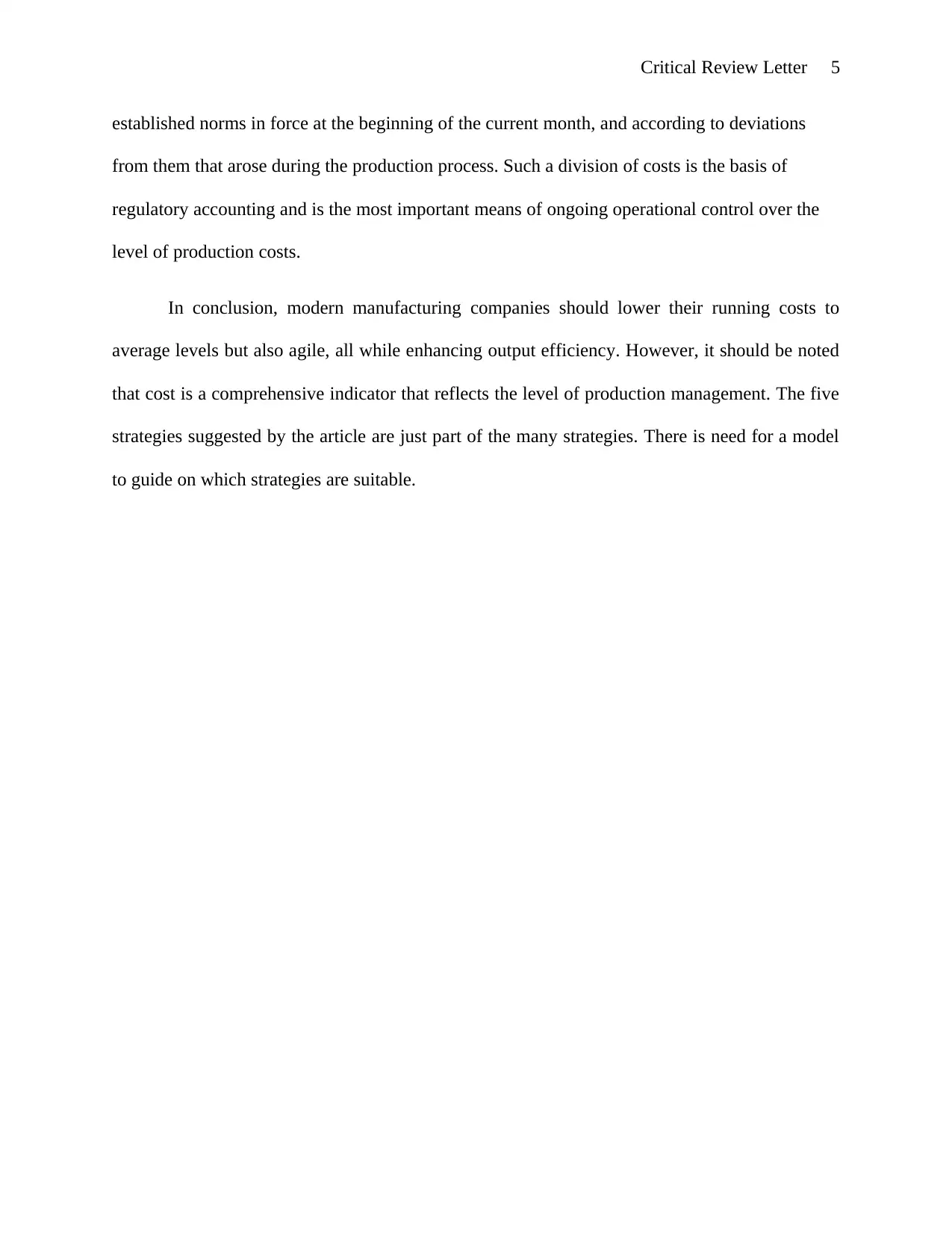
Critical Review Letter 5
established norms in force at the beginning of the current month, and according to deviations
from them that arose during the production process. Such a division of costs is the basis of
regulatory accounting and is the most important means of ongoing operational control over the
level of production costs.
In conclusion, modern manufacturing companies should lower their running costs to
average levels but also agile, all while enhancing output efficiency. However, it should be noted
that cost is a comprehensive indicator that reflects the level of production management. The five
strategies suggested by the article are just part of the many strategies. There is need for a model
to guide on which strategies are suitable.
established norms in force at the beginning of the current month, and according to deviations
from them that arose during the production process. Such a division of costs is the basis of
regulatory accounting and is the most important means of ongoing operational control over the
level of production costs.
In conclusion, modern manufacturing companies should lower their running costs to
average levels but also agile, all while enhancing output efficiency. However, it should be noted
that cost is a comprehensive indicator that reflects the level of production management. The five
strategies suggested by the article are just part of the many strategies. There is need for a model
to guide on which strategies are suitable.
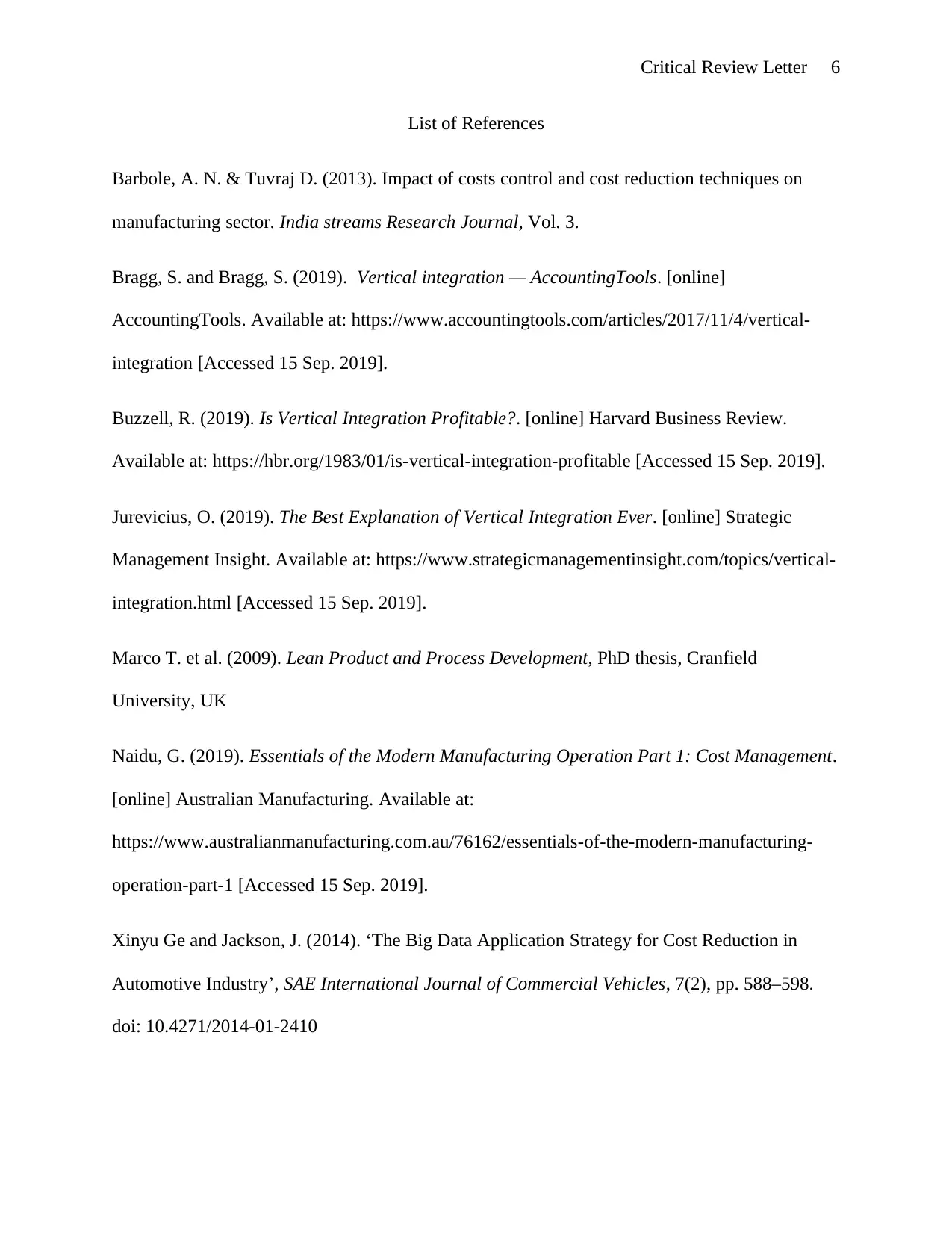
Critical Review Letter 6
List of References
Barbole, A. N. & Tuvraj D. (2013). Impact of costs control and cost reduction techniques on
manufacturing sector. India streams Research Journal, Vol. 3.
Bragg, S. and Bragg, S. (2019). Vertical integration — AccountingTools. [online]
AccountingTools. Available at: https://www.accountingtools.com/articles/2017/11/4/vertical-
integration [Accessed 15 Sep. 2019].
Buzzell, R. (2019). Is Vertical Integration Profitable?. [online] Harvard Business Review.
Available at: https://hbr.org/1983/01/is-vertical-integration-profitable [Accessed 15 Sep. 2019].
Jurevicius, O. (2019). The Best Explanation of Vertical Integration Ever. [online] Strategic
Management Insight. Available at: https://www.strategicmanagementinsight.com/topics/vertical-
integration.html [Accessed 15 Sep. 2019].
Marco T. et al. (2009). Lean Product and Process Development, PhD thesis, Cranfield
University, UK
Naidu, G. (2019). Essentials of the Modern Manufacturing Operation Part 1: Cost Management.
[online] Australian Manufacturing. Available at:
https://www.australianmanufacturing.com.au/76162/essentials-of-the-modern-manufacturing-
operation-part-1 [Accessed 15 Sep. 2019].
Xinyu Ge and Jackson, J. (2014). ‘The Big Data Application Strategy for Cost Reduction in
Automotive Industry’, SAE International Journal of Commercial Vehicles, 7(2), pp. 588–598.
doi: 10.4271/2014-01-2410
List of References
Barbole, A. N. & Tuvraj D. (2013). Impact of costs control and cost reduction techniques on
manufacturing sector. India streams Research Journal, Vol. 3.
Bragg, S. and Bragg, S. (2019). Vertical integration — AccountingTools. [online]
AccountingTools. Available at: https://www.accountingtools.com/articles/2017/11/4/vertical-
integration [Accessed 15 Sep. 2019].
Buzzell, R. (2019). Is Vertical Integration Profitable?. [online] Harvard Business Review.
Available at: https://hbr.org/1983/01/is-vertical-integration-profitable [Accessed 15 Sep. 2019].
Jurevicius, O. (2019). The Best Explanation of Vertical Integration Ever. [online] Strategic
Management Insight. Available at: https://www.strategicmanagementinsight.com/topics/vertical-
integration.html [Accessed 15 Sep. 2019].
Marco T. et al. (2009). Lean Product and Process Development, PhD thesis, Cranfield
University, UK
Naidu, G. (2019). Essentials of the Modern Manufacturing Operation Part 1: Cost Management.
[online] Australian Manufacturing. Available at:
https://www.australianmanufacturing.com.au/76162/essentials-of-the-modern-manufacturing-
operation-part-1 [Accessed 15 Sep. 2019].
Xinyu Ge and Jackson, J. (2014). ‘The Big Data Application Strategy for Cost Reduction in
Automotive Industry’, SAE International Journal of Commercial Vehicles, 7(2), pp. 588–598.
doi: 10.4271/2014-01-2410
⊘ This is a preview!⊘
Do you want full access?
Subscribe today to unlock all pages.

Trusted by 1+ million students worldwide

Critical Review Letter 7
Zhiran, Xu & Mengxiao, Z. (2012). Cost reduction in the automobile industry, case studies of
the Chinese market. www.diva-portal.org.
Zhiran, Xu & Mengxiao, Z. (2012). Cost reduction in the automobile industry, case studies of
the Chinese market. www.diva-portal.org.
Paraphrase This Document
Need a fresh take? Get an instant paraphrase of this document with our AI Paraphraser
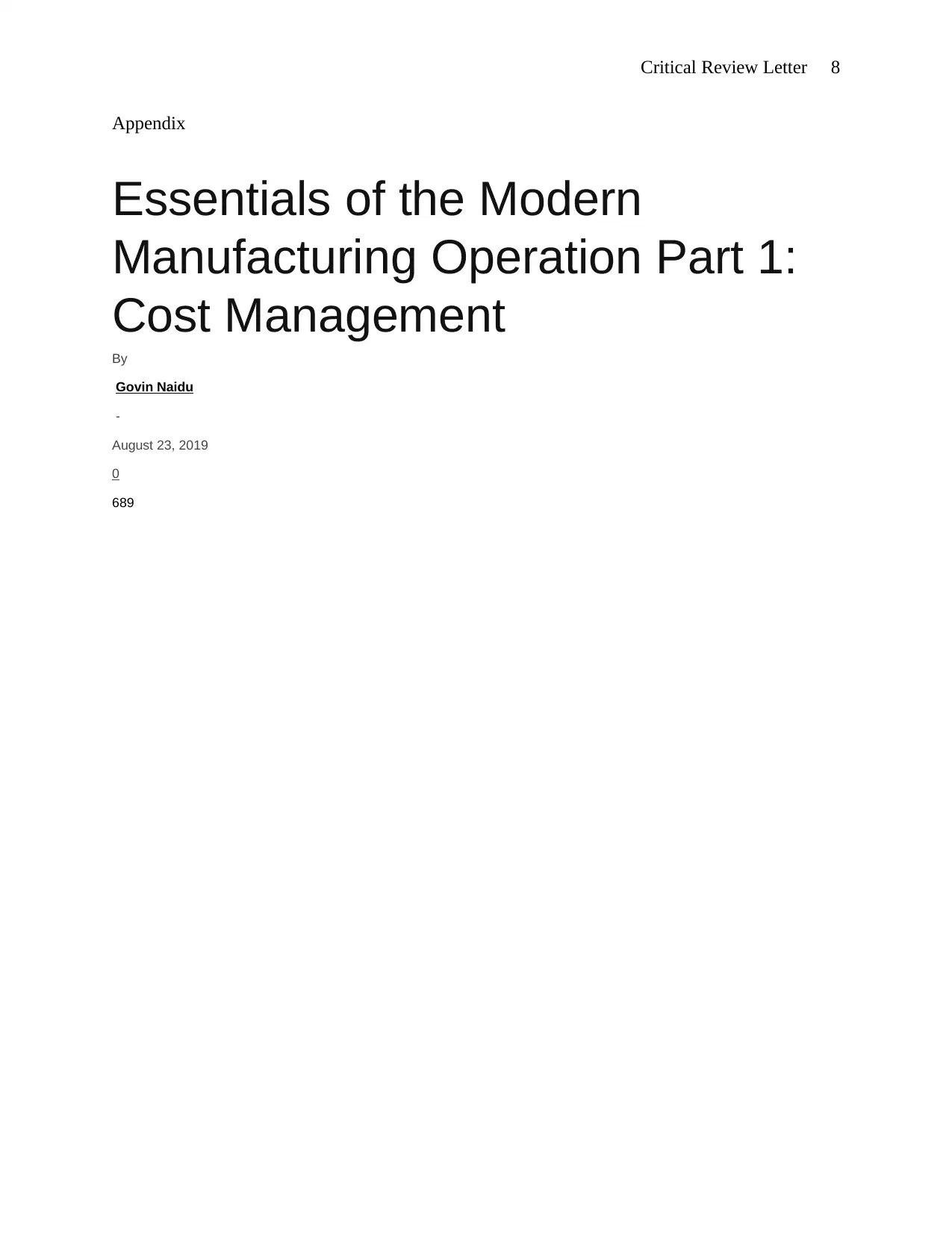
Critical Review Letter 8
Appendix
Essentials of the Modern
Manufacturing Operation Part 1:
Cost Management
By
Govin Naidu
-
August 23, 2019
0
689
Appendix
Essentials of the Modern
Manufacturing Operation Part 1:
Cost Management
By
Govin Naidu
-
August 23, 2019
0
689
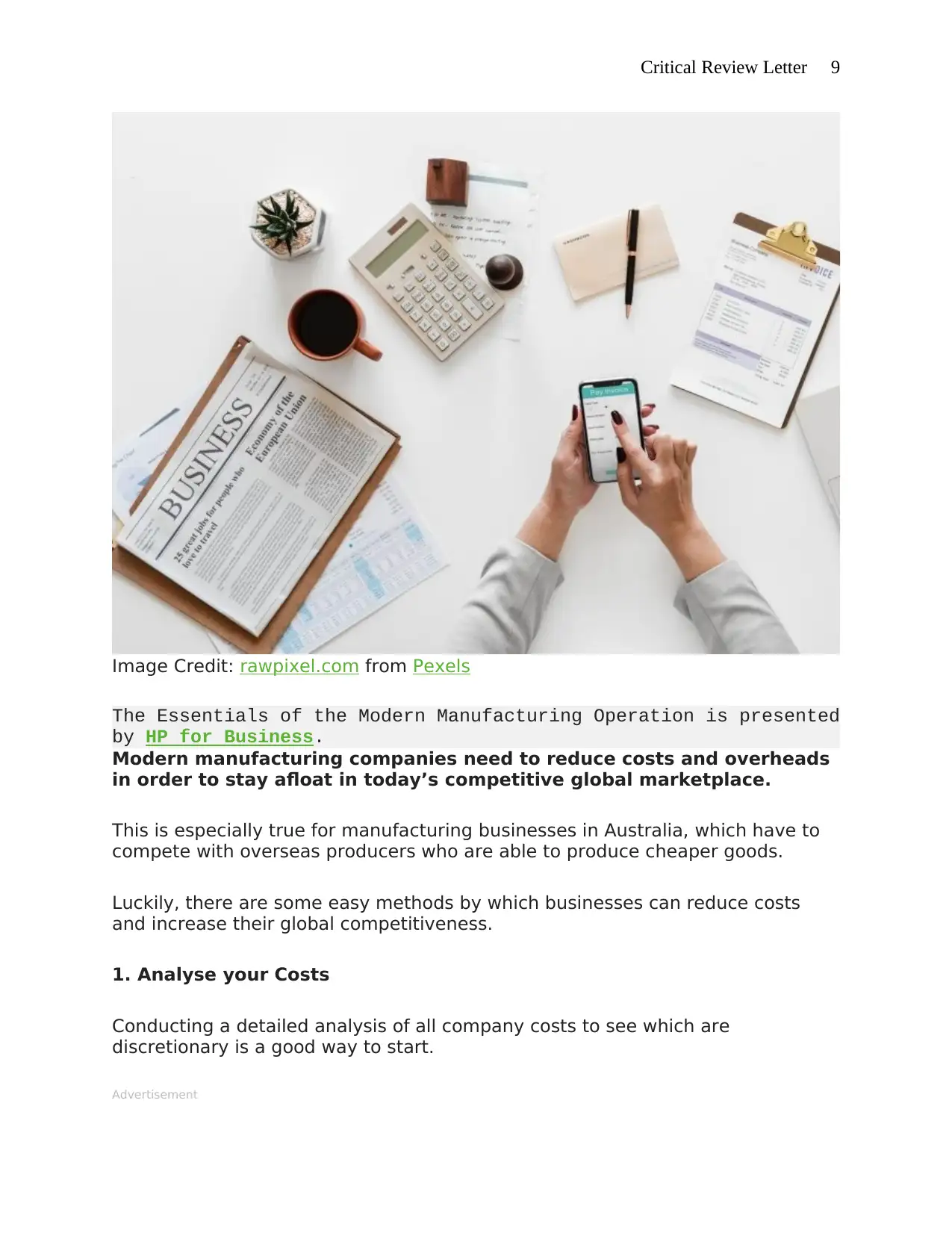
Critical Review Letter 9
Image Credit: rawpixel.com from Pexels
The Essentials of the Modern Manufacturing Operation is presented
by HP for Business.
Modern manufacturing companies need to reduce costs and overheads
in order to stay afloat in today’s competitive global marketplace.
This is especially true for manufacturing businesses in Australia, which have to
compete with overseas producers who are able to produce cheaper goods.
Luckily, there are some easy methods by which businesses can reduce costs
and increase their global competitiveness.
1. Analyse your Costs
Conducting a detailed analysis of all company costs to see which are
discretionary is a good way to start.
Advertisement
Image Credit: rawpixel.com from Pexels
The Essentials of the Modern Manufacturing Operation is presented
by HP for Business.
Modern manufacturing companies need to reduce costs and overheads
in order to stay afloat in today’s competitive global marketplace.
This is especially true for manufacturing businesses in Australia, which have to
compete with overseas producers who are able to produce cheaper goods.
Luckily, there are some easy methods by which businesses can reduce costs
and increase their global competitiveness.
1. Analyse your Costs
Conducting a detailed analysis of all company costs to see which are
discretionary is a good way to start.
Advertisement
⊘ This is a preview!⊘
Do you want full access?
Subscribe today to unlock all pages.

Trusted by 1+ million students worldwide
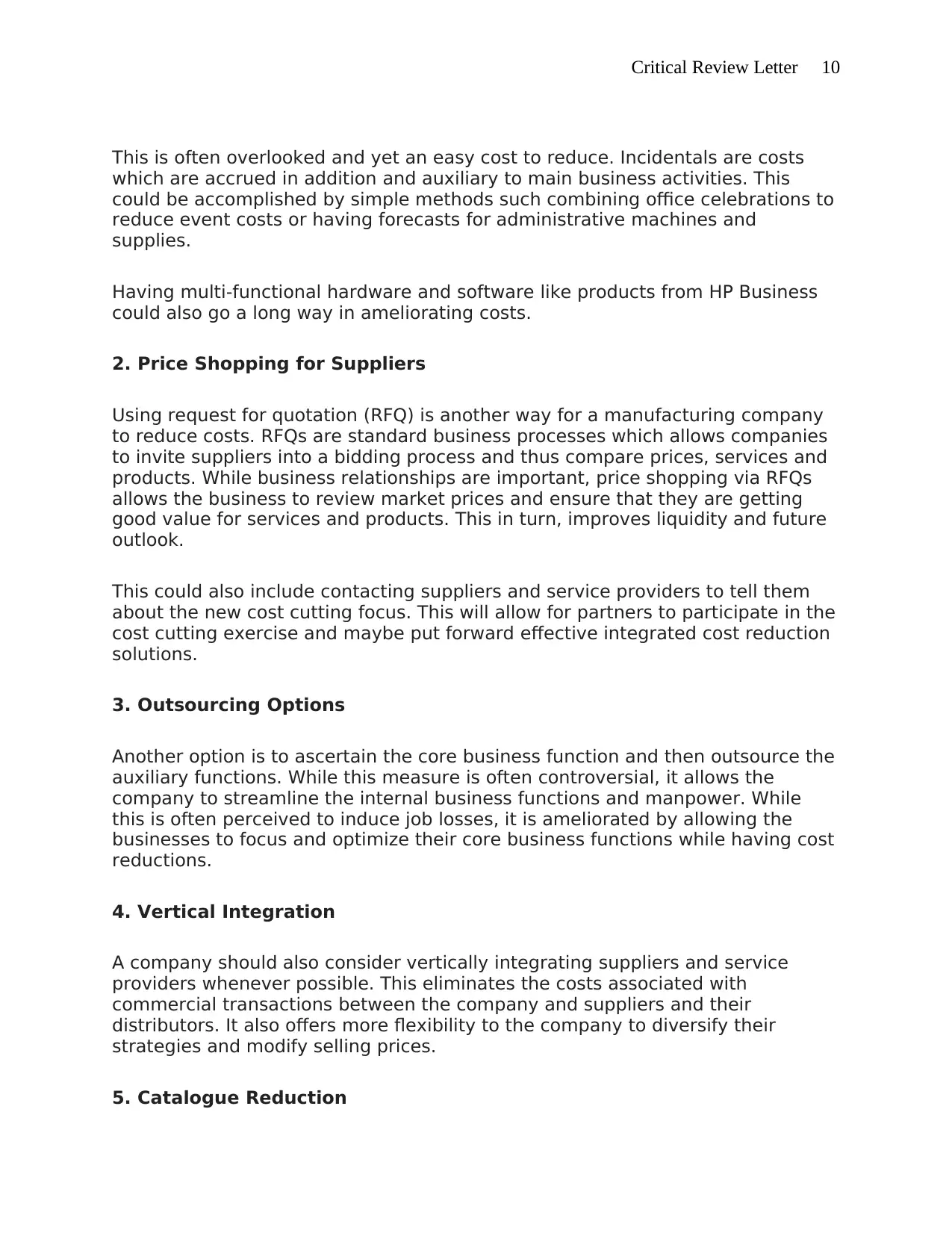
Critical Review Letter 10
This is often overlooked and yet an easy cost to reduce. Incidentals are costs
which are accrued in addition and auxiliary to main business activities. This
could be accomplished by simple methods such combining office celebrations to
reduce event costs or having forecasts for administrative machines and
supplies.
Having multi-functional hardware and software like products from HP Business
could also go a long way in ameliorating costs.
2. Price Shopping for Suppliers
Using request for quotation (RFQ) is another way for a manufacturing company
to reduce costs. RFQs are standard business processes which allows companies
to invite suppliers into a bidding process and thus compare prices, services and
products. While business relationships are important, price shopping via RFQs
allows the business to review market prices and ensure that they are getting
good value for services and products. This in turn, improves liquidity and future
outlook.
This could also include contacting suppliers and service providers to tell them
about the new cost cutting focus. This will allow for partners to participate in the
cost cutting exercise and maybe put forward effective integrated cost reduction
solutions.
3. Outsourcing Options
Another option is to ascertain the core business function and then outsource the
auxiliary functions. While this measure is often controversial, it allows the
company to streamline the internal business functions and manpower. While
this is often perceived to induce job losses, it is ameliorated by allowing the
businesses to focus and optimize their core business functions while having cost
reductions.
4. Vertical Integration
A company should also consider vertically integrating suppliers and service
providers whenever possible. This eliminates the costs associated with
commercial transactions between the company and suppliers and their
distributors. It also offers more flexibility to the company to diversify their
strategies and modify selling prices.
5. Catalogue Reduction
This is often overlooked and yet an easy cost to reduce. Incidentals are costs
which are accrued in addition and auxiliary to main business activities. This
could be accomplished by simple methods such combining office celebrations to
reduce event costs or having forecasts for administrative machines and
supplies.
Having multi-functional hardware and software like products from HP Business
could also go a long way in ameliorating costs.
2. Price Shopping for Suppliers
Using request for quotation (RFQ) is another way for a manufacturing company
to reduce costs. RFQs are standard business processes which allows companies
to invite suppliers into a bidding process and thus compare prices, services and
products. While business relationships are important, price shopping via RFQs
allows the business to review market prices and ensure that they are getting
good value for services and products. This in turn, improves liquidity and future
outlook.
This could also include contacting suppliers and service providers to tell them
about the new cost cutting focus. This will allow for partners to participate in the
cost cutting exercise and maybe put forward effective integrated cost reduction
solutions.
3. Outsourcing Options
Another option is to ascertain the core business function and then outsource the
auxiliary functions. While this measure is often controversial, it allows the
company to streamline the internal business functions and manpower. While
this is often perceived to induce job losses, it is ameliorated by allowing the
businesses to focus and optimize their core business functions while having cost
reductions.
4. Vertical Integration
A company should also consider vertically integrating suppliers and service
providers whenever possible. This eliminates the costs associated with
commercial transactions between the company and suppliers and their
distributors. It also offers more flexibility to the company to diversify their
strategies and modify selling prices.
5. Catalogue Reduction
Paraphrase This Document
Need a fresh take? Get an instant paraphrase of this document with our AI Paraphraser
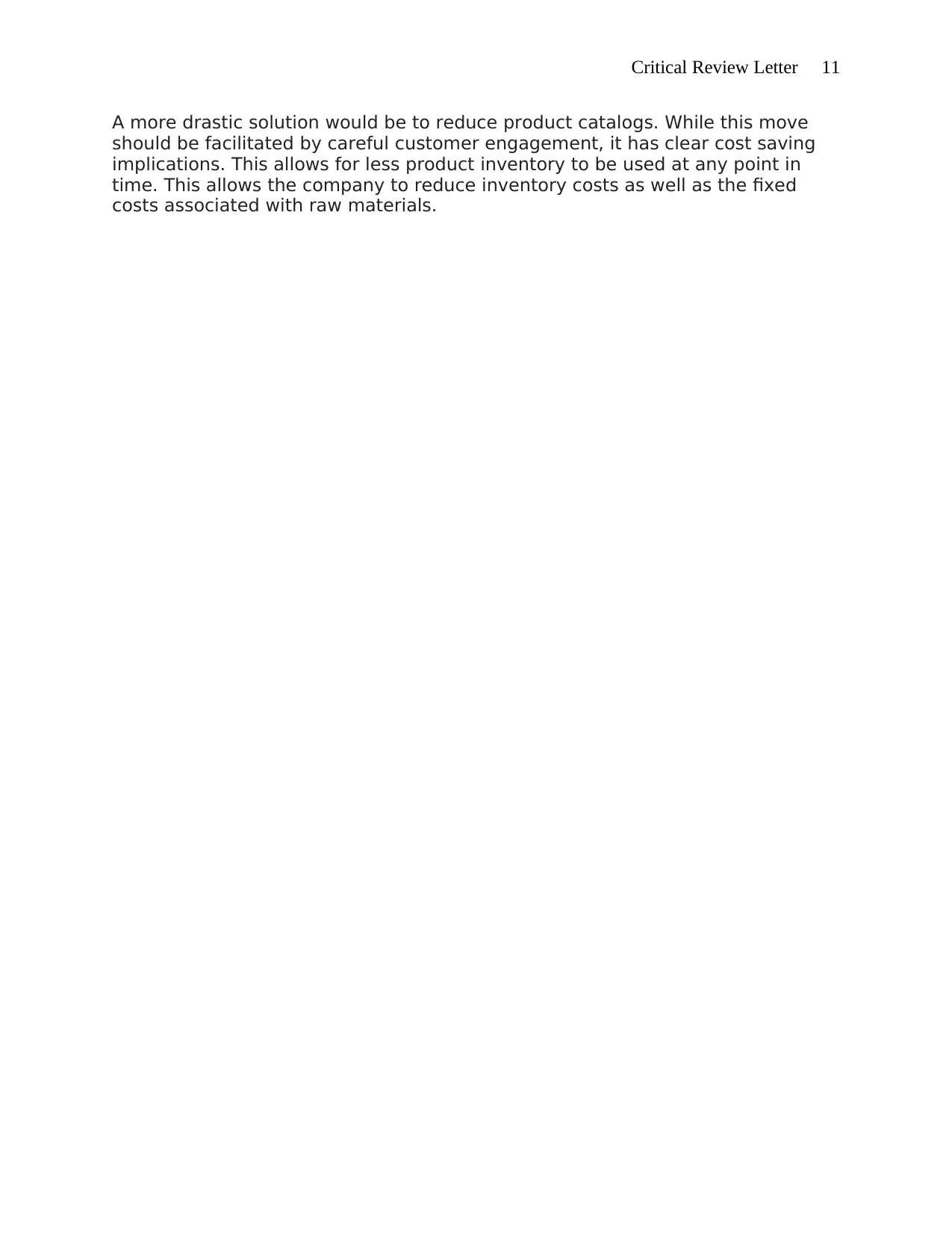
Critical Review Letter 11
A more drastic solution would be to reduce product catalogs. While this move
should be facilitated by careful customer engagement, it has clear cost saving
implications. This allows for less product inventory to be used at any point in
time. This allows the company to reduce inventory costs as well as the fixed
costs associated with raw materials.
A more drastic solution would be to reduce product catalogs. While this move
should be facilitated by careful customer engagement, it has clear cost saving
implications. This allows for less product inventory to be used at any point in
time. This allows the company to reduce inventory costs as well as the fixed
costs associated with raw materials.
1 out of 11
Related Documents
Your All-in-One AI-Powered Toolkit for Academic Success.
+13062052269
info@desklib.com
Available 24*7 on WhatsApp / Email
![[object Object]](/_next/static/media/star-bottom.7253800d.svg)
Unlock your academic potential
Copyright © 2020–2025 A2Z Services. All Rights Reserved. Developed and managed by ZUCOL.





